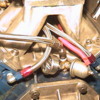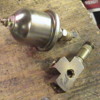...Wanted Pictures? You got Pictures!! Jack was 'Dead-On! The original gauge reads 40 lbs. at first fire-up, while the Mechanical reads 80+ lbs. And the Original stays at 40 lbs. when Hot and at an Idle! Obviously I can't tell You what the Mechnical reads while driving. Since I needed a third port for the 'Oil By-Pass'; I took a vintage Bronz 'T' fitting and drilled and tapped the side for a 1/8 NPT-45 Degree Elbow, to mount the 'Back Mount' Gauge. Yes! What protruded into the Bore was reemed clear! Machinists can do that! The second picture shows the new sender for a red led Digital gauge, soon to be installed. Think that will be acurate? H*ll Yes!! In the second picture you also see another 'T' that I had laying around My shop, the 1/8 NPT already tapped in, and has a 1/4 NPT extension on it. If You want it, it's yours, or if you want a 'T' WITHOUT the 4th port, I have many of those, also. Just give me Your mailing address and I'll send Them right off to You! At MY expenss! I guess I'am just feeling like a 'Nice Guy', Today; and You live in The Great State of California. The Sender is NOT included. My Email: pantera1974@verizon.net ...



